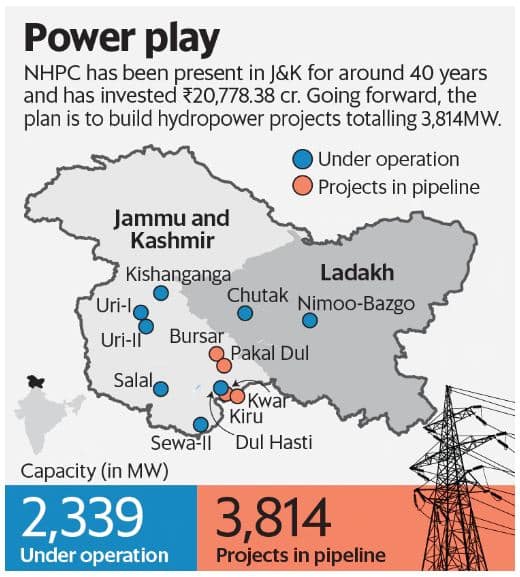- The Indus Water Treaty is a water distribution Treaty or Agreement between India and Pakistan, signed in 1960.
- The Indus Water Treaty was signed between the then-Indian Prime Minister Jawaharlal Nehru and the then-Pakistani President Ayub Khan.
- The World Bank brokered the Indus Water Treaty meeting between the two countries. On the recommendations of the UN (Permanent Indus Commission), the World Bank came up with the Indus Water Treaty in 1954, and the Treaty was signed on September 19, 1960.
- The treaty sets out a mechanism for cooperation and information exchange between the two sides on the use of the water of the Indus River and its five tributaries: Sutlej, Beas, Ravi, Jhelum, and Chenab.
Brief history
- The Indus river basin has six rivers- Indus, Jhelum, Chenab, Ravi, Beas and Sutlej
- These rivers originate from Tibet and flow through the Himalayan ranges to enter Pakistan, ending in the south of Karachi.
- In 1947, the line of partition, aside from delineating geographical boundaries for India and Pakistan, also cut the Indus river system into two.
- Both the sides were dependent on water from the Indus river basin to keep their irrigation infrastructure functional and therefore, equitable distribution was needed.
- Initially, the Inter-dominion accord of May 1948 was adopted.
- According to this, both countries, after meeting for a conference, decided that India would supply water to Pakistan in exchange for an annual payment made by the latter.
- This agreement however, soon disintegrated as both the countries could not agree upon its common interpretations.
- In 1951, in the backdrop of the water-sharing dispute, both the countries applied to the World Bank for funding of their respective irrigation projects on ??the Indus and its tributaries.
- This is when the World Bank offered to mediate the conflict.
- Finally in 1960, after nearly a decade of fact-finding, negotiation, proposals by the World Bank and amendments to them, an agreement was reached between the two countries.
- The Indus Waters Treaty (IWT) was signed by former Prime Minister Jawaharlal Nehru and then President of Pakistan, Ayub Khan.
- The former Vice President of the World Bank, W.A.B. Iliff, also signed it.
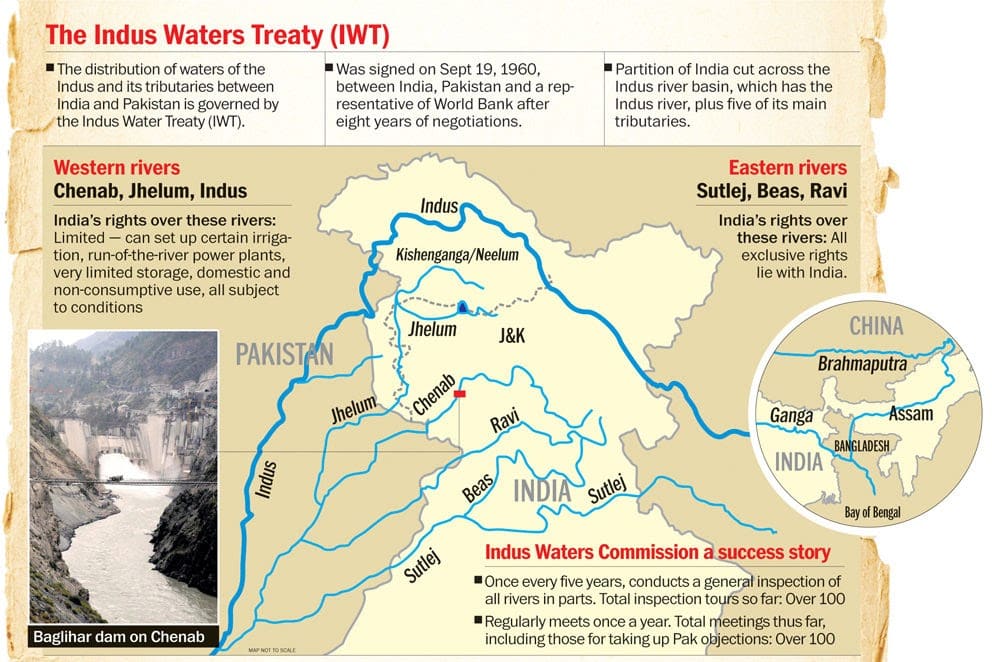
Key Provisions of the Indus Waters Treaty (IWT):
- The treaty prescribed how water from the six rivers of the Indus River System would be shared between India and Pakistan.
- It allocated the three western rivers—Indus, Chenab and Jhelum—to Pakistan for unrestricted use.
- Barring certain non-consumptive, agricultural and domestic uses by India.
- The three Eastern rivers—Ravi, Beas and Sutlej—were allocated to India for unrestricted usage.
- This means that 80% of the share of water or about 135 Million Acre Feet (MAF) went to Pakistan, while leaving the rest 33 MAF or 20% of water for use by India.
- It allocated the three western rivers—Indus, Chenab and Jhelum—to Pakistan for unrestricted use.
- It also required both the countries to establish a Permanent Indus Commission constituted by permanent commissioners on both sides.
- The functions of the commission include serving as a forum for exchange of information on the rivers, for continued cooperation and as the first stop for the resolution of conflicts.
- While Pakistan has rights over the waters of Jhelum, Chenab and Indus,
- Annexure C of the Indus Waters Treaty allows India certain agricultural uses, and
- Annexure D allows it to build ‘run of the river‘ hydropower projects, meaning projects not requiring live storage of water.
- It also provides certain design specifications which India has to follow while developing such projects.
- The treaty also allows Pakistan to raise objections over such projects being built by India, if it does not find them to be compliant with the specifications.
- India has to share information on the project design or alterations made to it with Pakistan, which is required to respond with objections, if any, within three months of receipt.
- Besides, India is allowed to have a minimum storage level on the western rivers – meaning it can store up to 3.75 MAF of water for conservation and flood storage purposes.
Dispute resolution mechanism
- The IWT also provides a three-step dispute resolution mechanism, under which
- “Questions” on both sides can be resolved at the Permanent Commission, or can also be taken up at the inter-government level.
- In case of unresolved questions or “differences” between the countries on water-sharing, such as technical differences, either side can approach the World Bank to appoint a Neutral Expert (NE) to come to a decision.
- And eventually, if either party is not satisfied with the NE’s decision or in case of “disputes” in the interpretation and extent of the treaty, matters can be referred to a Court of Arbitration.
- IWT does not have a unilateral exit provision and is supposed to remain in force unless both the countries ratify another mutually agreed pact.
Criticisms:
- Internationally, the Treaty is seen as one of the most successful cases of conflict resolution but between the two countries, it has seeded dissatisfaction and conflicts regarding its interpretation and implementation.
- The treaty is highly technical leading to far-ranging divergences between the two countries in terms of interpretations.
- For example, the treaty says that storage systems can be built but to a limited extent. However, the technical details make it difficult to conclude under what circumstances projects can be carried out.
- Another concern is the tense political relations between the two countries.
- From the Indian point of view:
- The basic dissatisfaction is that the treaty prevents it from building any storage systems on the western rivers, even though it allows building storage systems under certain exceptional circumstances.
- From Pakistan’s point of view:
- Due to its suspicions, stays aware of every technical aspect of the project and deliberately tries to get it suspended.
- The matter is further aggravated by the fact that the western rivers lie in the disputed region of Jammu and Kashmir, a subject of a tussle between both since independence.
- From the Indian point of view:
Reasons for Dissatisfaction with Indus Waters Treaty
- India’s View: IWT prevents the country from building any storage systems on the western rivers. The treaty lays out that, while under certain exceptional circumstances storage systems can be built, the complaint raised by India is that Pakistan deliberately stops any such effort due to the political rivalry it shares with India.
- Pakistan’s View: It objects Indian claims of not utilizing the share of water in Western rivers, and that construction of storage dams would not abrogate the treaty .
Does the treaty favour Pakistan?
- Pakistan gets 80% of the water in the 6-river Indus system. This is 90 times greater volume of water than Mexico’s share under a 1944 pact with the US.
- It is Asia’s only treaty with specific water-sharing formulas on cross-border flows.
- A virtual line on the Indian map splits the Indus basin. India’s sovereignty lies in the lower rivers, Pakistan’s in the upper.
- Only water pact compelling an upper riparian state to defer to the interests of a downstream state.
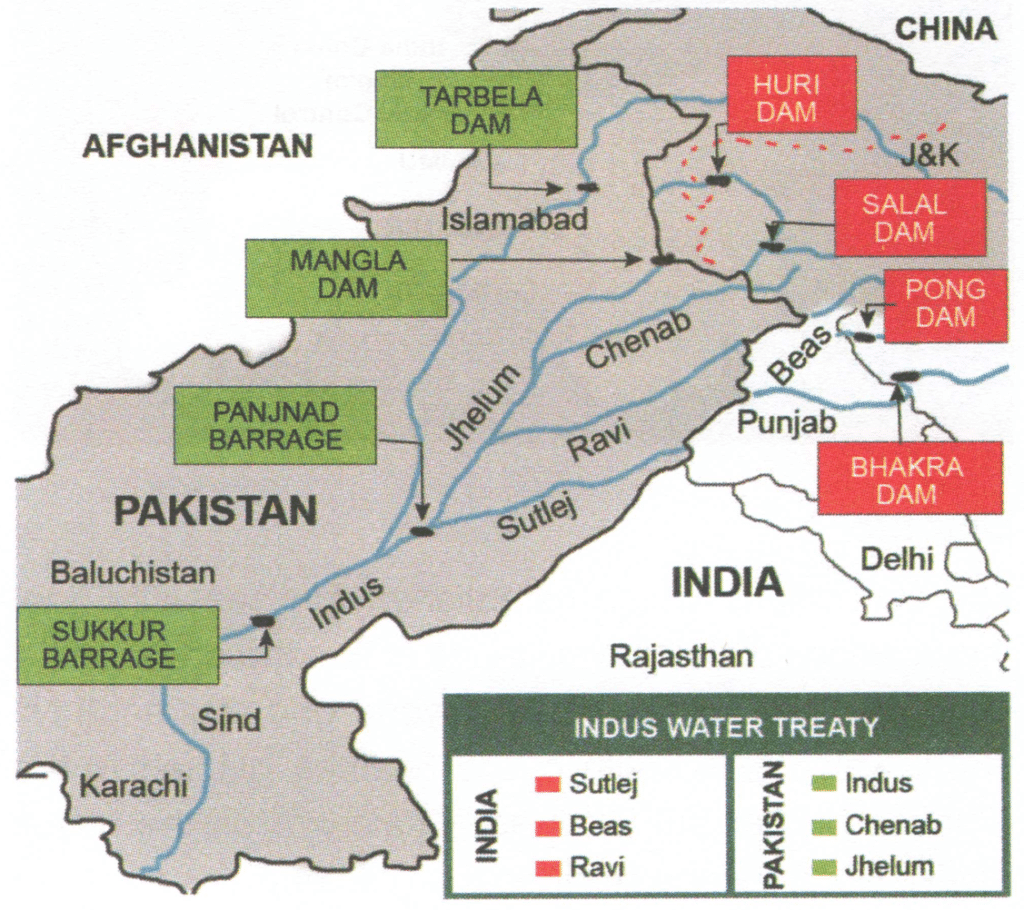
Need for renegotiation
- Pakistan has always claimed unfair treatment.
- Climate change concerns bother Pakistan more.
- Advancement in water storage and management technologies.
- Whenever India has tried to use newer designs and technologies, Pakistan has objected, like with the Baglihar dam.
- Need for joint management, greater flexibility in utilisation of waters, and adoption of basin-wise approach in the management of the river waters.
- Some Pakistani voices also hope that a renegotiation of the Treaty would allow China to become a party, which would then neutralise India’s advantage.
India’s Stand
- Internal debate on renegotiation or quitting the treaty.
- Post-Uri Attacks – ‘blood and water cannot flow together’.
- Clamour for weaponsing the Treaty.
- It can be viewed as India’s counter measure to Pakistan’s repeated objections to every irrigation or power project on the Indian side of the Indus basin.
- Considering Pakistan’s desperate dependence on the Indus basin rivers, this in itself could be extremely unsettling.
Why is India rethinking on this treaty?
- Mostly favours Pakistan: Equitable it may have seemed, but the fact remained that India conceded 80.52 percent of the aggregate water flows in the Indus system to Pakistan.
- Unnecessarily generous: It also gave Rs 83 crore in pounds sterling to Pakistan to help build replacement canals from the western rivers. Such generosity is unusual of an upper riparian.
- Reclaiming riparian rights: India conceded its upper riparian position on the western rivers for the complete rights on the eastern rivers. Water was critical for India’s development plans.
Current Issues
- Both the countries are involved in a dispute over the 330 MW Kishanganga project and the 850 MW Ratle project being built on the Jhelum and Chenab rivers.
- Objecting to the design of the Kishenganga project, Pakistan said it flouted provisions of the Indus Waters Treaty and would result in a 40% reduction of water flow.
- Pakistan also wants the storage capacity of the Ratle project to be reduced from 24 million cubic metres to 8 million cubic metres.
Kishanganga Hydroelectric Project
- The Kishanganga project is located 5 km north of Bandipore in Jammu and Kashmir, India.
- It is a run-of-the-river project that includes a 37 m tall concrete-face rock-fill dam.
- It requires to divert water from the Kishanganga River through a tunnel to a power plant in the Jhelum River basin.
- It will have an installed capacity of 330 MW.
- The construction of this hydroelectric project began in 2007.
- Pakistan objected to the project arguing that it will affect the flow of the Kishanganga River (called the Neelum River in Pakistan).
- In 2013, The Hague’s Permanent Court of Arbitration (CoA) ruled that India could divert all the water with certain conditions.
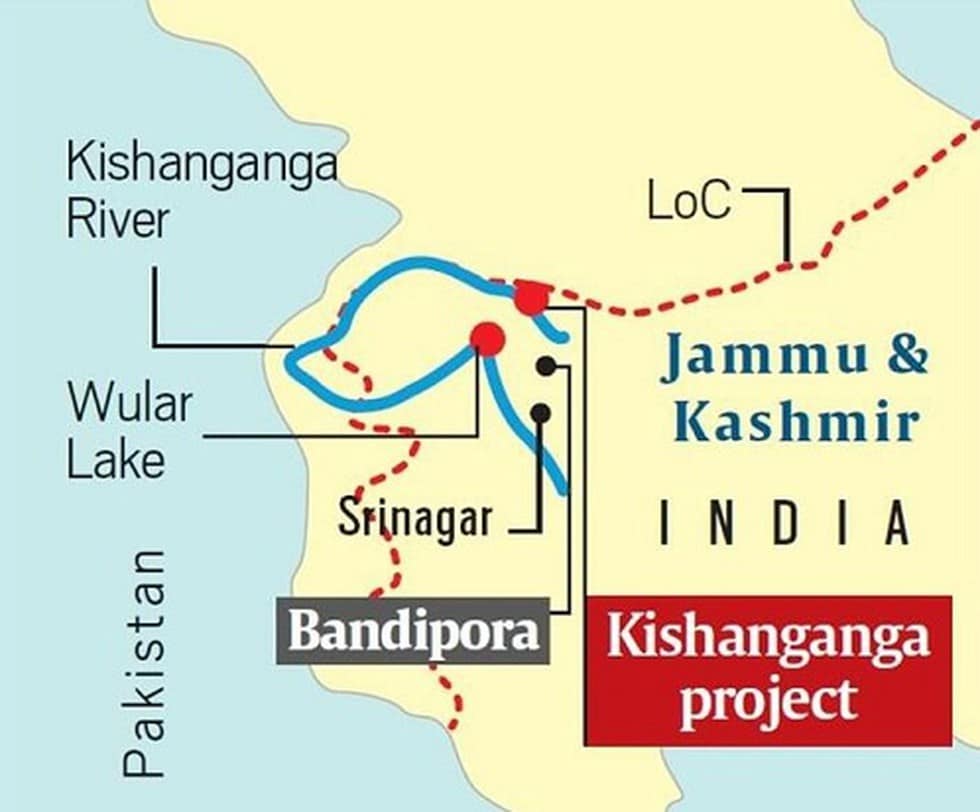
Ratle Hydroelectric Project
- It is a run-of-the-river hydroelectric power station on the Chenab River, Kishtwar district of the Indian Union Territory of Jammu and Kashmir.
- It includes a 133 m tall gravity dam and two power stations adjacent to one another.
- The installed capacity of both power stations will be 850 MW.
- In June 2013, the then Indian Prime Minister laid the foundation stone for the dam.
- Pakistan has frequently alleged that it violates the Indus Water Treaty, 1960.
- It envisages an investment of about Rs. 5282 crore and the project shall be commissioned within a span of 60 months.
- Other Projects on Chenab Basin:
- Kiru Hydro Electric (HE) Project:
- The Kiru HE Project of 624 MW installed capacity is proposed on river Chenab (Kishtwar district).
- Pakal Dul (Drangdhuran) Hydroelectric Project:
- It is a reservoir based scheme proposed on river Marusudar, the main right bank tributary of river Chenab in Kishtwar Tehsil of Doda District in Jammu & Kashmir.
- Dulhasti Power Station:
- It is run-of-the-river with an installed capacity of 390 MW to harness the hydropower potential of river Chenab (Kishtwar district).
- Salal Power Station:
- It is a run-of-the-river scheme with an installed capacity of 690 MW to harness the Hydropower potential of river Chenab. It is located in Reasi district of Jammu & Kashmir.
- Kiru Hydro Electric (HE) Project:
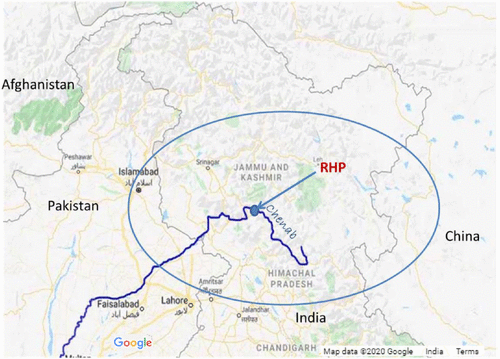
Significance of the treaty
- Testimonial to peaceful coexistence: It is a treaty that is often cited as an example of the possibilities of peaceful coexistence that exist despite the troubled relationship.
- Survived many hostilities: It has survived 3 crucial wars.
- Most successful bilateral treaty: It is internationally regarded as an example of successful conflict resolution between two countries otherwise locked in a hostile relationship.
Why has the treaty survived?
- India’s generosity: It is for India’s generosity on Pakistan for sharing waters of its own rivers.
- Free flow of waters: India has refrained from weaponizing waters. Pakistan cannot survive without this treaty.
- Huge dependence Pak economy: About 80% of Pakistan’s agriculture depends on Indus and the riparian rivers waters.
- Humanitarian grounds: Floods and droughts will starve ordinary Pakistanis while their politicians would still live in luxury.
- India’s credibility: Backtracking on the treaty could affect India’s stand as global reliable partner who disrespects bilateral agreements.
Way Forward
- The role of India, as a responsible upper riparian abiding by the provisions of the treaty, has been remarkable but the country is under pressure to rethink the extent to which it can remain committed to the provisions, as its overall political relations with Pakistan becomes intractable.
- IWT is often cited as an example of the possibilities of peaceful coexistence that exist despite the troubled relationship between both neighboring countries.
- In the last six decades the Indus Waters Treaty has been successful in keeping the water sharing disputes at bay which signifies its importance. However, in the present times of climate crisis coupled with natural disasters the demands of water sharing of both the countries have changed. Therefore there is a need to renegotiate the treaty terms, update certain technical specifications and expand the scope of the agreement to address demands of the two countries amid the rising climate crisis.
Hydroelectric Projects
India has constructed the following dams utilizing the waters of the Eastern rivers which have been exclusively allocated to India. These Projects include the Pong and Pandoh Dam on Beas, Ranjit Sagar on Ravi, and Bhakra Dam on Satluj.
- The works like the Madhopur-Beas Link, Beas-Sutlej Link, and Indira Gandhi Nahar Project have helped India utilize nearly 95 % of the waters of Eastern rivers.
- Even after all this, around 2 MAF (Million Acre Feet) of water from Ravi is still reported to be flowing unutilized to Pakistan, annually. To stop the flow of these waters that belong to India for its utilization, India has taken up recent projects:
- Ravi Beas 2nd Link below Ujh- The government of India declared this project as National Project. Through this project, the government is planning to tap excess water flow through the river Ravi in Pakistan. It will be done by constructing a barrage across the river Ravi for diverting water through a tunnel linked to the Beas basin. The government of India declared this project a National Project.
- Ujh multipurpose project- Ujh is a tributary of the Ravi river. This project will create storage of water on river Ujh for irrigation and power generation in India. This project is accredited with the National Project tag.
- Shahpurkandi Project- The construction of the Shahpurkandi Project is being undertaken by the Government of Punjab under the monitoring of the Government of India. This project will help in utilizing the waters coming out from the powerhouse of Ranjit Sagar or the Thein dam for irrigation and power generation in the state of Punjab and UT of Jammu and Kashmir.
